In Mayan, Labná means old or abandoned house. It is one of the five main Puuc sites, including Xlapak, Sayil, Kabah, and Uxmal (the last two of which are included on this site). This peaceful hill settlement had a population at its height of about 4500 persons. It includes a so-called palace consisting of more than 60 rooms, another recently restored structure called the Temple of the Columns, a watchtower (Mirador) atop a mostly disintegrated pyramid, and perhaps the most beautiful of all Mayan arches. The style of all the buildings is usually defined as late Puuc (9th-10th century CE)--a style characterized by stone mosaic friezes made up of masks, lattice work, and other stylized elements (zigzags representing serpents, for example).
The arch from the East
This arch is not free-standing as the arches at Uxmal and Kabah are, but is a passage within a building complex. The Mayan arch uses the principle of the corbeled vault, although more typically as a system for roofing interior spaces. Here, however, the vault penetrates the facade and opens to the outside. On the east side large stepped frets project from a background of colonnettes; these stepped frets meet in a V, perhaps suggesting a stylized mask while the zigzags below suggest the feathered serpent, recurrent in Mayan myth. A low roof comb crowns the arch.
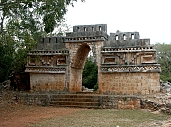
|
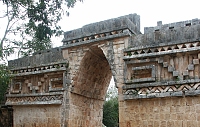
|
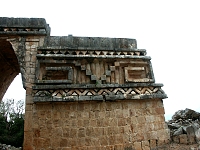
|
| |
|
The arch from the West |
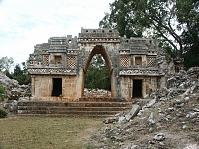
|
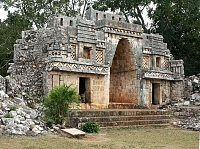
|
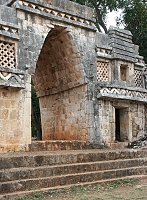
|
| |
|

|
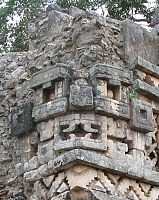
|
The Chaac maskA large mask projects on the northwest corner. This Chaac mask, like most in Mayan culture, has lost it elephantine snout.
|
| |
|
Stylized Mayan hutsNiches in the frieze resemble the doors to Mayan thatched roofed huts, which are set above the stylized serpent motif. |
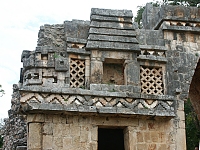
|
| |
|
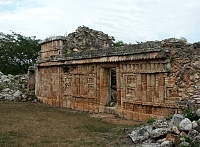
|
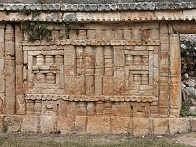
|
The remaining wall extending north from the archThe wall is decorated with embedded columns, some short and squatty, and engraved designs. A small door with sloping slides penetrates the wall. |
| |
|
The Mirador (or Watch Tower or Observatory)This structure is thought to be early Puuc (that is, older than other buildings on the site). It is a three-room structure with a towering roof crest on the front wall. |
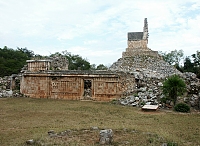
|
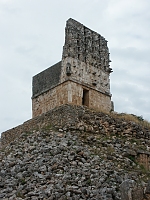
|















 Go to the Mexico Index.
Go to the Mexico Index. Click here to return to index of art historical sites.
Click here to return to index of art historical sites.
 Click here to return to index of artists and architects.
Click here to return to index of artists and architects.
 Click here to return to chronological index.
Click here to return to chronological index.
 Click here to see the home page of Bluffton College.
Click here to see the home page of Bluffton College.
